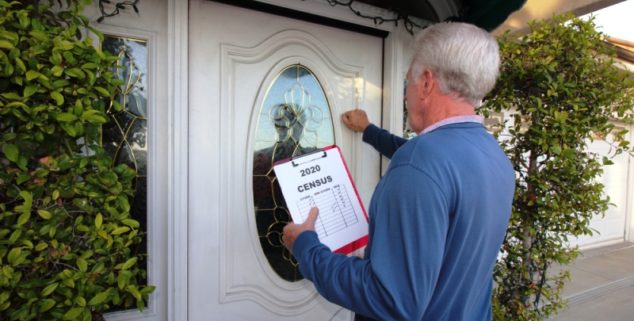News
Delayed census could greatly affect CA redistricting
 A Census worker canvassing a neighborhood. (Photo: Wayne Via, Shutterstock)
A Census worker canvassing a neighborhood. (Photo: Wayne Via, Shutterstock)Pushing back the census deadlines could have a profound political impact on California, ultimately forcing the state to draw scores of political districts for the 2022 elections within a tiny, two-week window.
The Trump administration wants a 120-day delay in developing and reporting the finished data. The plan, which requires congressional approval, was announced earlier by Census Bureau Director Steven Dillingham and Commerce Secretary Wilbur Ross.
Door-to-door in-person canvassing already was suspended in March and will be halted until at least June 1 because of the coronavirus pandemic.
Recent numbers showed about half of all U.S. households — 48 percent, or 70 million — had completed the online census questionnaire, a new process that is being used for the first time in the 2020 census.
“We’re losing four months,” said Assemblyman Rob Bonta, D-Alameda, who authored legislation signed by the governor to make sure cities and counties redraw their political districts after each federal census. The bill, AB 849, expands public input in the map-making, particularly for groups who are often bypassed by the census, and requires the finished maps to be made public at least a week before the deadline for more comment and analysis.
“The whole process is about community engagement, outreach and input,” he said, “a discussion about communities of interest.”
The delay would create a ripple effect: The final data used to draw the new maps for California’s congressional, legislative and Board of Equalization districts may not be available to the state’s Independent Citizens Redistricting Commission until the end of July 2021, instead of earlier in March, as expected. The 177 maps currently include 120 legislative seats, 53 congressional districts and four Board of Equalization seats.
By law, the districts must be drawn using the latest census data. In turn, that means drawing the districts’ boundaries would have to be completed from scratch within about two weeks, by Aug. 15, the state’s constitutional deadline – a virtually impossible task, experts say.
“This is really a big deal,” said Matt Rexroad, a veteran political strategist, who noted that that crafting fair districts typically entails numerous meetings throughout the state in which the commission gathers comments and analyses from community leaders, political experts, advocates for the poor and underserved communities, representatives of non-English speakers, and others.
“It takes months of hearings around the state, months of meetings and town halls with communities of interest. That would just be not possible” under the Trump administration’s plan. “I’m not so sure congress is going to let this happen,” Rexroad said.
The data is eagerly awaited.
California, its population growth flatlining, may lose a seat in Congress, cutting its House delegation to 52. But that won’t be known until the final data is available. State numbers from the Finance Department put California’s growth rate between July 2018 and July 2019 at .35% the lowest rate of increase since the early 1900s.
Federal resources are allocated on the basis of the census, and California receives about 80 percent of its federal dollars – about $77 billion – through calculations based upon the census. The money is a critical piece of the state’s programs, especially transportation, welfare and health care.
In California, as in the nation, the count is going slowly.
“We still only have about a 50% completion rate for the #2020Census. Take a short break from #TigerKing memes to ensure CA gets the representation & funding we deserve. Each missed person will cost us $20,000+ over the next decade in Fed funding,”state Sen. Bill Dodd, D-Napa, tweeted Monday.
California state has spent about $200 million to ensure as accurate a count as possible — an enormous amount in comparison with other states but well worth it when calculating the magnitude of the federal dollars at stake.
Complicating the count this year is the COVID-19 epidemic. “I think things are going as well as they can, considering what we’re facing,” Ditas Katague, California’s census director, told the Sacramento Bee in an April 1 report.* At the time, about a third of California households had responded.
Lawmakers and the governor are looking for ways to expand that two-week window.
Sen. Tom Umberg, D-Santa Ana, has authored a bill to push back the 2022 primary election to June, thus easing the time crunch on the map drawing and candidates’ filing deadlines. His bill, SB 970, does not affect presidential primaries, which would remain in March consolidated with state primaries.
“Non-presidential primaries should be set to their traditional date of June,” Umberg said earlier in a written statement. “We need to set our elections on dates that will maximize voter turnout and engagement.”
He added that “by moving the non-presidential primary back to June we will be providing local government enough time to complete their required work.”
—
Editor’s Note: Corrects 17th graf to show Ditas Katague quote was from Sacramento Bee interview, not governor’s briefing.
Want to see more stories like this? Sign up for The Roundup, the free daily newsletter about California politics from the editors of Capitol Weekly. Stay up to date on the news you need to know.
Sign up below, then look for a confirmation email in your inbox.

Leave a Reply